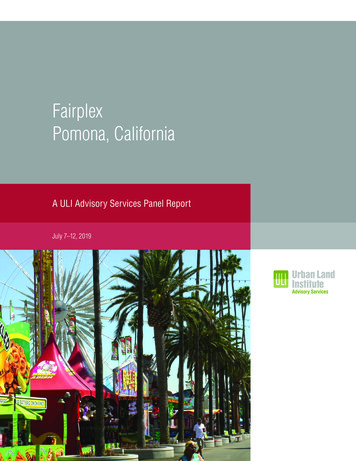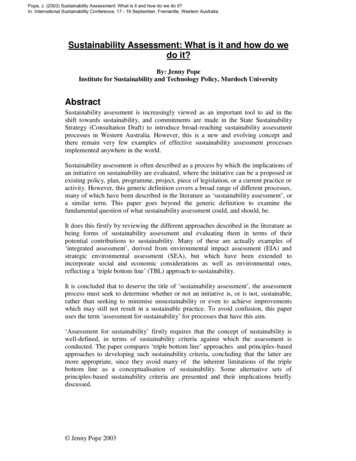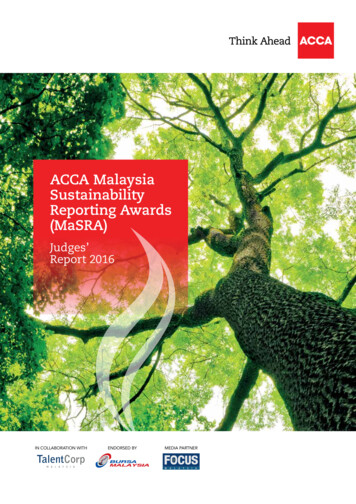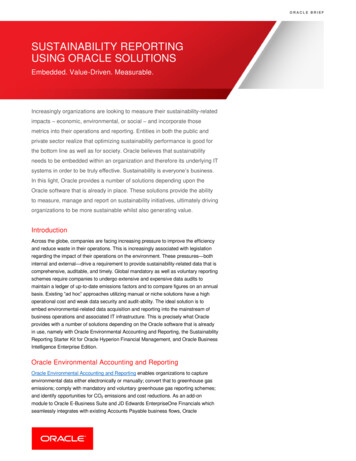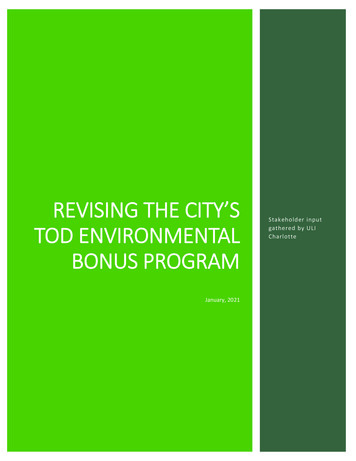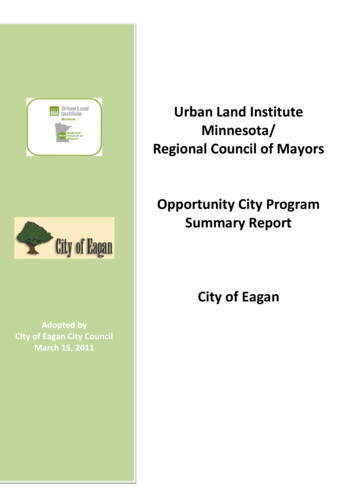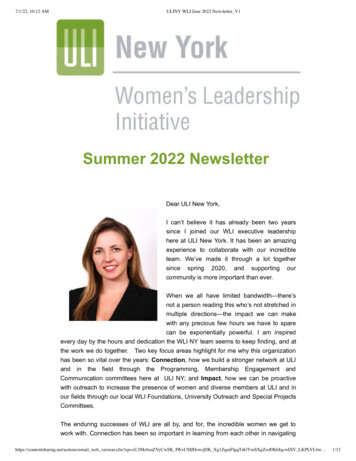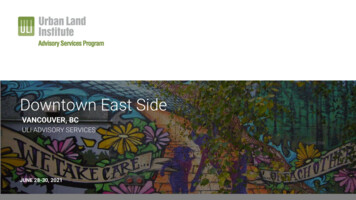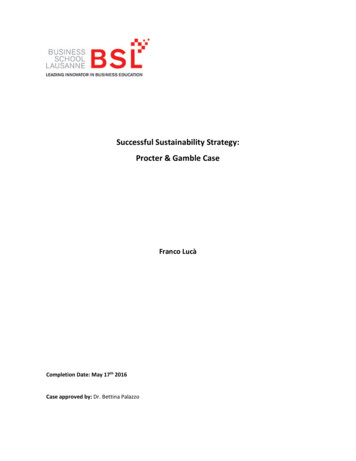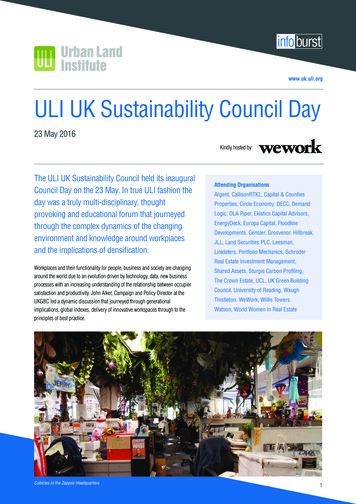
Transcription
www.uk.uli.orgULI UK Sustainability Council Day23 May 2016Kindly hosted by:The ULI UK Sustainability Council held its inauguralCouncil Day on the 23 May. In true ULI fashion theday was a truly multi-disciplinary, thoughtprovoking and educational forum that journeyedthrough the complex dynamics of the changingenvironment and knowledge around workplacesand the implications of densification.Attending OrganisationsArgent, CallisonRTKL, Capital & CountiesProperties, Circle Economy, DECC, DemandLogic, DLA Piper, Ekistics Capital Advisors,EnergyDeck, Europa Capital, FloodlineDevelopments, Gensler, Grosvenor, Hillbreak,JLL, Land Securities PLC, Leesman,Linklaters, Portfolio Mechanics, SchroderReal Estate Investment Management,Workplaces and their functionality for people, business and society are changingaround the world due to an evolution driven by technology, data, new businessprocesses with an increasing understanding of the relationship between occupiersatisfaction and productivity. John Alker, Campaign and Policy Director at theUKGBC led a dynamic discussion that journeyed through generationalimplications, global indexes, delivery of innovative workspaces through to theprinciples of best practice.Cubicles in the Zappos HeadquartersShared Assets, Sturgis Carbon Profiling,The Crown Estate, UCL, UK Green BuildingCouncil, University of Reading, WaughThistleton, WeWork, Willis TowersWatson, World Women in Real Estate1
. in Japan and manyother cities wherepeople are lessintegrated in societyas a result of peopleinteracting more withtechnology thanwith wider society.Employees in Cubicle FarmMobile technology and availability of data isinfluencing how businesses, cities, peopleand society utilise buildings as shared byLucy Barratt, Sustainability Project Assistant,Grosvenor. Interestingly these factors arelikely to drive change for the long-term asthe newest generation (Generation Z) havenot known a world without the web.Lucy highlighted that as the world adapts toa more advanced technological era, societalimplications of technology should be bettermanaged as there are already examples inJapan and many other cities where peopleare less integrated in society as a result ofpeople interacting more with technology thanwith wider society. To address this challengeit was suggested that buildings can play agreater role to provide spaces that allow forpeople integrate into a community withgreater consideration given to the spacessurrounding a building to facilitate thisprocess.Measuring occupier satisfaction andperformance is a complex and oftensubjective process but when applied over alarge data set it can be achieved as indicatedby the Leesman Index. Chris Moriarty,2Leesman’s Development Director, sharedhow the Leesman Index has assessed over180,000 globally revealing the followinginsights: Variety in the workplace is the greatestbooster to workplace effectiveness; noiseis the biggest negative force. Open plan environments must supportthe former whilst trying to reduce thelatter; not always easy. Top 15 locations have fully unallocatedworkspaces Key factor that sets the top locationsapart is spaces that bring people together Desks and chairs are regarded as ahygiene factor and it is more importantto have an office that can bring peopletogether Happiest workers are under 25yrs butthis result should also consider the jobrole and wider complexity of activityprofile of this age group High choice, flexibility environmentssee a 74% agreement with Leesman’sproductivity question which is higherthan the average of 56% Tea and coffee are seen as a fundamentalsocial matter When applying flexible workingenvironments, it is ‘all in or nothing’ asopen plan, flexible environments withoutthe right level of choice and variety areamong the worst performing workplacesin the Index Buildings are often not shaped aroundpeople.Collaborative and flexible workplaces allowfor buildings to be utilised more intenselywith demand for such space growing rapidlyin the last 5 years. Mary Finnigan, WeWork’sHead of Legal Counsel, provided the Councilwith insights into how the organisation isleading the market demand for collaborativespaces but also serving a need to addressindividual access to an ‘office’ acrossflexible working environments. Insight intoWeWork’s occupiers (members) andapproach: A lack of politics as often associated withlarge organisations Encourage collaboration - 70% ofmembers collaborate Interior design plays an important rolewith 85% satisfaction of the space Social programmes further support theflexible work ‘movement’ with a summercamp planned for 2016 An App further facilities the connectionbetween members and allows for tailoredand global collaboration to take place.
Wild West End, http://www.wildwestend.london/Designing for occupier satisfaction andhigher workplace productivity requires amulti-faceted approach. Philip Tidd,Principle, Gensler provided athought-provoking insight into theprinciples and insights he has gained fromover 20 years of workplace consultancy.Philip shared that the most satisfied workerswithin the EMEA are the Nordic countrieswhere work-life balance, accessibility andless intense working hours are all cited askey influencing factors. Insights fromPhilip’s discussion included:Workplaces Most buildings only actively utilise40% of their space Average occupancy of senior peopleis 15% The most successful organisations gobeyond certification Intense change of use of overtime andthe new way of working provides anopportunity to build in optimisation.ChallengesPrinciples Real Estate is currently measured onasset value not building functionalityor occupier satisfaction Legal barriers such as floor platespecification limit workplace satisfactionin the UK while in Germany and othercountries there is an allowance for muchcloser working spaces People are hardwired to connect withnature and the BCO UK office standardsdo not address this issue New buildings are often let from‘specification’ and the reality is thespace does not always meet the needsof the users ‘Holy grail’ of office productivity andsatisfaction is delivering the right mixof open space yet allowing for diversityand adaptability. No one-size fits all approach – whatworks for Google doesn’t always workfor others Consideration should be given tocultures on both a local andorganisation level Design a workspace to meet the needsof a range of personality types and notjust extroverts Include sustainability practices thatconsider people’s health and wellbeing.Transforming workplaces to open plan withflexible workspaces often have unintendedconsequences that influence thepersonalisation of the workplace. Anexample of where unintended consequencesof a workplace refurbishment had a negativeimpact is Rabobank in the Netherlands.The refurbishment was led by the financialteams and the resulting design lacked asense of place resulting in a significantreduction in satisfaction across their3,500 employees.3
Employee satisfaction of a workplace isstrongly linked to employee retention butshould consider factors such as flexibleworking hours, organisational culture andthe facilitation of engaging and connectingemployees. The Bank of America realisedthat its employees lacked a socialconnection and introduced standard breaktimes, resulting in increased staffcommunication, satisfaction and ultimatelystaff retention. Further highlights from thediscussion around the theme of changingworkplaces included: Optimal number of workdays in the officeare considered to be 3, not 5, per weekand this is largely driven by workplacemobility where people often work outsideof the office and in more flexibleconditions The UK may work longer work weeks butthere are other EU countries who workless with an equal or greater level ofproductivity, indicating that the optimumnumber of work days for productivitywould be less than the traditional 5 days As buildings are adapted for moreflexible use, consideration should begiven to retaining a sense of place,especially for non-autonomous workerswho require a regular space to delivercore operational needs Workplace flexibility has significantsustainability benefits, where a greaterutilisation of space could lead tobuildings being utilised for 18hrs p/dayrather than the traditional 9-10hrs The sharing economy is poised to makeuse of the flexible workplace opportunityand it is anticipated that real estate willradically change within the next 5 years Shaping workplaces for ultimateproductivity and employee satisfaction isa complex field that should also considerthe interrelationship between the publicand private sector, healthy lifestylechoices and good density within thecontext of an evolving urban area.The Council discussed the complexity of thechanging workplace and highlighted that thischallenge is strongly interlinked with widersocietal health and wellbeing. Some organisations are addressing this challenge butthere is a need for a more collaborative oreven policy-driven approaches.Key considerations included: Physiological wellbeing is especiallyimportant where air quality in large citiessuch as London and New York are killingpeople faster than the normal ageingprocess Delivery of solutions is a macrochallenge and requires the joining upof private and public sectors to deliverland use for the betterment of the widersociety There is an opportunity to re-think greenspaces and solutions this are alreadybeing implemented, such as the WildWest End initiative with its green roofsacross west London and bringing greenspaces into a building delivered in thePasona H.Q. in Tokyo. Business improvement districts providean opportunity for organisations to worktogether on these matters “Liveable cities” are emerging as anindicator of quality workingenvironments with walkability andcycling forming key principles Better Places for People was highlightedas global campaign addressing ona H.Q. in Tokyo – garden in middle of office4
Urban Land Institute Robert de JongUrban Density: resilience and resource efficiencyWe are in a period of rapid urbanisation withover half the world’s population living inurban areas and this increase will seearound 5 billion people living in cities by2030. Increased urbanisation will placegreater demand for land-use putting strainon resource, lifestyle and health, both ofpeople and the ecosystems that supporturban areas. The Council set out to answerhow do forms of density influence theenvironmental capacity, productivity andliveability of our cities? A cross-sector panelled by Simon Sturgis, Director, SturgisCarbon explored this topic through the eyesof the urban planning, the circular economy,urban realm and large scale urbanregeneration schemes.PlanningProf. Yvonne Rydin, Bartlett School ofPlanning, UCL spoke about the principlesinfluencing the planning and densificationof urban areas, highlighting that planningneeds to be seen in the ‘reality’ ofinterlinking cycles, where not all aspects ofdensification occur at the same time yet theirinfluences to the overall delivery of an urbanarea need to be considered. Improvedprimary transport was a key example thatillustrates how increases in capacity willinfluence an areas ability to densify but asurban areas become more developed,transport is often operating at over-capacityand subsequently a limiting factor to furthergrowth.Delivering sustainable urban growth anddensity therefore requires a holistic view thatgoes beyond the building realm. Currentgovernment resource and fiscal approachesare limiting the UK to adopt a holisticapproach, however attendees felt that theGreater London Authority and, subsequently,new devolved regions in the UK could leadon a more coordinated approach todensification and planning.Circular EconomyResources are often viewed within a linearcontext of ‘cradle to grave’ but a relativelynew approach is to view resources within a‘Circular Economy’ where waste is seen as aresource and the cycle of products can beutilised in a more sustaining way. KlaskeKruk, Director of Programmes at CircleEconomy, shared an insightful presentationinto the procedures, research and facilitationher organisation is conducting with industrysectors and cities to provide a level ofcoordination and planning within this field.5
Urban RealmHow buildings, urban areas and cities areplanned has far reaching consequences forthe health and well-being of citizens.Claudine Blamey, Head of Sustainability andStewardship at The Crown Estate, providedan inspiring presentation into howimprovement to the public realm in areas ofLondon have brought far reaching benefitsboth in terms of footfall (walking) andbusiness uplift. Changing small lanestraditionally used for deliveries and backof house services into public realm, hasresulted in a greater utilisation of buildingsfor street level amenities and increase thewalkable regions of the city.Klaske Kruk, Circle Economy Sustainability Council Day PresentationGoing beyond single resource use and asingle organisation, Klaske shared howCircle Economy mapped the resourcesand waste for cities such as Glasgow andAmsterdam, resulting in the valuableresource re-use and collaboration betweenhitherto un-connected industries.6(click on image to view presentation)As cities densify the circular economy willhave increasing importance to provide amechanism to limit resource waste butalso consider the long-term sustainabilityconsequences of the resources we all use,supported by long-term leadership.Urban realm improvements by The CrownEstate may increase footfall but also considerthe increasing challenge of air quality andthe importance of biodiversity in these partsof the London. The Crown is working withleading businesses and land owners throughthe ‘Wild West End’ initiative that aims toimprove the streetscape with more plantsand install green roofs to increasebiodiversity and create important linkagesbetween Regent’s Park and St James’ Park.http://www.wildwestend.london/
Urban RegenerationDelivering a large scale regeneration schemethat meets the needs of densification but alsoconsiders longer-term sustainability is asignificant challenge and one that Argent hasbeen striving to achieve at King’s Cross.Peter Runacres, Senior Project Director,at Argent shared how the King’s Crossdevelopment is continuing to evolve butwhere consideration for higher density needsfor the area and wider London were a maininfluence for the sites development.Highlights from the presentation andsubsequent discussion included: Argent’s 10 principles guide for themaster plan coupled with a longer-termcommitment to the growth of the site andconnection with London and beyond High density and management ofcongestion are a main influence for KingsCross with plot ratios of 4:1 creating asense of openness to a relatively denselydeveloped area Density is tailored across the area withflexibility of use built in across thescheme The scheme also has a Master Strategywhich takes into consideration thebroader reach of the development,factoring in neighbouring communitiesand the repurpose of historic buildings Sustainability has been planned from theonset with cooling networks integratedacross the site that connect all buildings Engagement with the community beforeconstruction and also throughout thedevelopment of the scheme withcontinual public access to areas of thesite to embed the community in thedevelopment process Much of the scheme has mid risebuildings; building heights should notexceed 9-11 stories.The Council discussed the complexity ofdensity and its implications of delivering‘best practice’. It was considered that densitycan reach a tipping point and that currentpolicy is not equipped to manage thisprocess. Policy should include a range ofstakeholder perspectives, and includelong-term planning, foresight andmulti-stakeholder parameters that arereflected across urban areas to controlbalance. There is also a need for visionarypeople at the planning level to ensuresuccessful density is achieved that valueslong-term resource and society qualities.www.uk.uli.orgKing’s Cross: funding urban regenerationULI UK Development Forum, March 2015At ULI’s second UK DevelopmentForum, 38 leading developers,investors and advisors gathered atArgent’s headquarters in King’sCross to learn about the financingchallenges and solutions at thismajor project in north London.With each year that passes, King’s Crossattracts increasing numbers of commercialoccupiers, residents and visitors asdevelopment takes shape and this formerindustrial blackspot is transformed into anew London district.than any of London’s other major projects – istestimony to how far perceptions of the areahave already changed for the better.The latest arrival, however, marks more of afinancial milestone for the project: this yearAustralianSuper agreed to take a 25 per centstake in King’s Cross, in its first direct Londoninvestment and only its second in the UK.Indeed, as Mike Lightbound, a Partner withArgent, observed, “One of the biggestchallenges was changing the perception ofKing’s Cross, from a place people wanted to getout of as quickly as possible to a destination.”AustralianSuper will join the original King’sCross Central Ltd Partnership (KCCLP)investors, which include Argent King’s CrossLimited Partnership, backed by HermesInvestment Management and Argent, as wellas London & Continental Railways and DHLSupply Chain.The early success here owes much to Argent,in its role as master developer and assetmanager, establishing from the outset keyguiding principles for development.The transaction is significant, not least becauseit is the first time new capital has come into thepartnership after 15 years of planning anddevelopment at the 67-acre site. It is also ahuge vote of confidence in the regeneration ofKing’s Cross when there are at least five yearsto go before development is complete.That one of Australia’s leading institutionalinvestors has alighted at King’s Cross – ratherThough a lot has changed with the project overthe years – the phasing and design havechanged dramatically – Argent has stuckresolutely with these original core principlesand they will continue to inform the businessplan. Among others, they state that KCCLPand King’s Cross will: Offer a robust urban framework –recognising that in many respects, the streetsand the squares are as important as thebuildings. As Lightbound remarked, buildingswill come and go.Hosted by: Argent: argentllp.co.uk Provide a lasting new place –acknowledging that King’s Cross is a long-termproject. “We’ve been working on it for the bestpart of 20 years but ultimately it will be part ofLondon forever,” said Lightbound. “That givesus a responsibility to deliver something that isspecial – not just something that can last the testof time but something that is flexible and canchange over time.” Promote accessibility – to the site and onthe site to create, in effect, a virtuous circle ofactivity. “The more people we attract to King’sCross, the more open we make it and the morecomfortable we make people feel then obviouslythe more people we get here and the more theyspend, the more value will be created.” – understandingthe area is vital to delivering a project of this size.“Back in 2007, this was something we were veryengaged with, before we even owned the land.This is recognising that a development likeKing’s Cross is not just about the land in thedevelopment, it’s about the area and aboutengaging with the area.”Kindly Sponsored by: Hogan Lovells: hoganlovells.comFurther details: King’s Cross Development Forum –InfoBurst (click on image to view) ULI Density Report (click on image to view)Upcoming SustainabilityCouncil Forums: Passive House Site Tour –Mayfair London. 11th August 2016 Further 2016 programme details willbe announced shortly.The Density Dividend: solutionsfor growing and shrinking citiesOctober 2015Authors:Prof Greg ClarkSenior Fellow, ULI EuropeDr Tim MoonenDirector of Intelligence at The Business of Cities Ltd7
8665 Hayden Place Cunningham GroupWhat is the Urban Land Institute?The Urban Land Institute (ULI) is an influential global organisation with a mission to provideleadership in the responsible use of land and in creating and sustaining thriving communitiesworldwide. Established in 1936, the ULI now has a membership of around 38,000 internationally.With this broad sector membership, the ULI facilitates invaluable opportunities for members toengage and learn from different disciplines and to deepen existing relationships withprofessionals from around the world.ULI is a neutral, non-lobbying and not-for-profit research and education Institute. ULI Councilsare formed to share best practice and experience and their meetings are run under ‘ChathamHouse rules’ to allow for stimulating and thought-provoking discussions.Author: Robert de Jong, ULI UKCopyright 2016by the Urban Land Institute.ULI Europe, all rights reserved. No part of thisreport may be reproduced in any form or by anymeans, electronic or mechanical, includingphotocopying or recording, or by anyinformation storage and retrieval system,without written permission of the publisher.ULI have sought copyright permission for allimages and tables.What is the ULI UK Sustainability Council?The Sustainability Council is a passionate and influential group that wants to accelerate the rapiduptake of sustainability across the UK real estate industry. The Council provides a safe harbor forhonest and insightful debate on the key issues facing the industry, and provides manyopportunities for learning from real projects and peer experiences, including by drawing frominternational examples and networks.This Council presents its members with a unique opportunity to connect with a group of highcaliber individuals who are focused on a proactive, forward looking and urban-scale response tosustainability.Areas of focus include: Resource efficiency in existing buildings (health, well-being, occupantproductivity and density), social cohesion and climate resilience. The Council ensures that itsagenda complement ULI’s wider agenda areas of interest, which currently include topics such asdensity and healthy cities.If you would like further information about the UK Sustainability Council please nability-council/ or contactRobert de Jong robert.dejong@uli.org for further details850 Liverpool Street,London EC2M 7PYUnited KingdomTelephone: 44 (0)20 7487 9570Fax: 44 (0)20 7486 8652Email: uk@uli.orgWeb: www.uk.uli.org I www.uli.org
Principle, Gensler p rovided a thought-provoking insight into the princ iples and insights he has gained from over 20 years of workplace consultancy. Philip shared that the most satisfied workers within the EMEA are the Nordic countries where work-life balance, accessibility and less intense working hours are all cited as k ey influencing factors.
